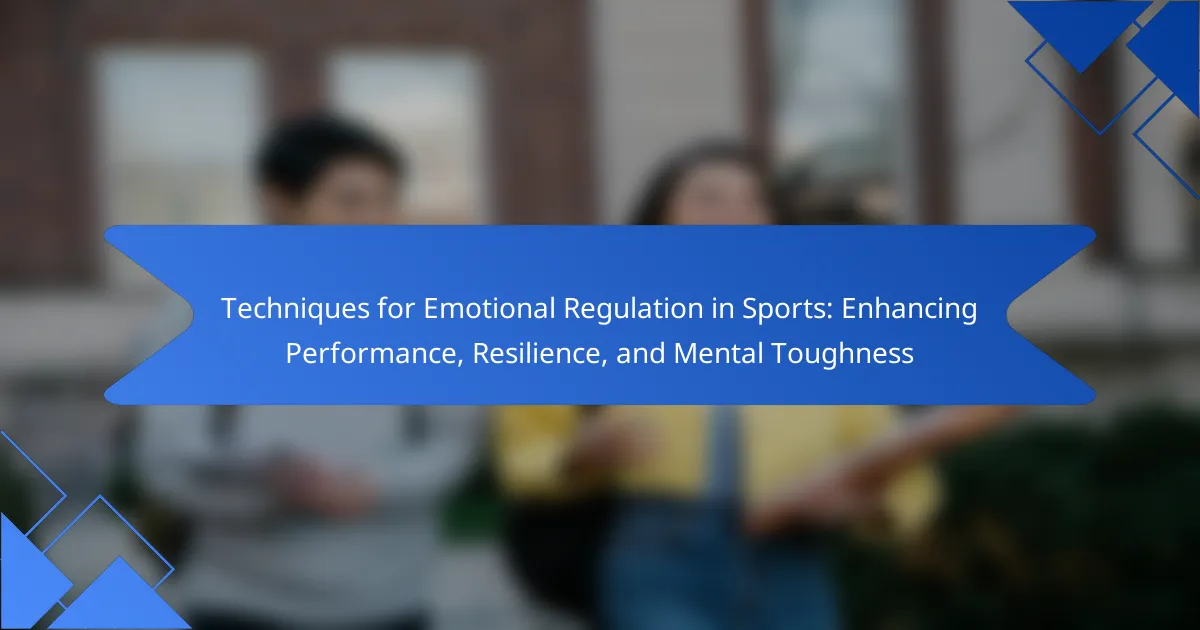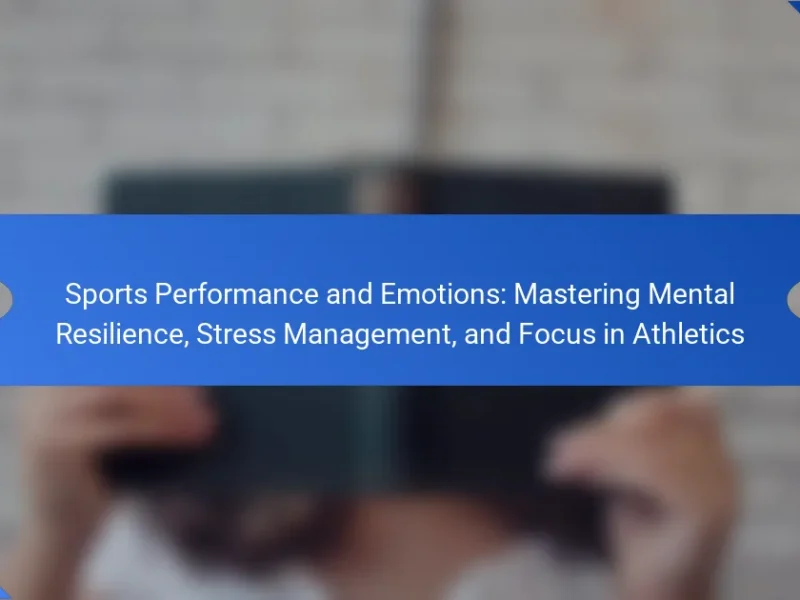Emotional regulation techniques are essential for athletes aiming to enhance performance, resilience, and mental toughness. Key strategies include mindfulness, cognitive restructuring, and breathing exercises. These methods help manage stress, maintain focus, and foster a positive mindset. Coaches play a crucial role in supporting athletes by implementing these techniques effectively.
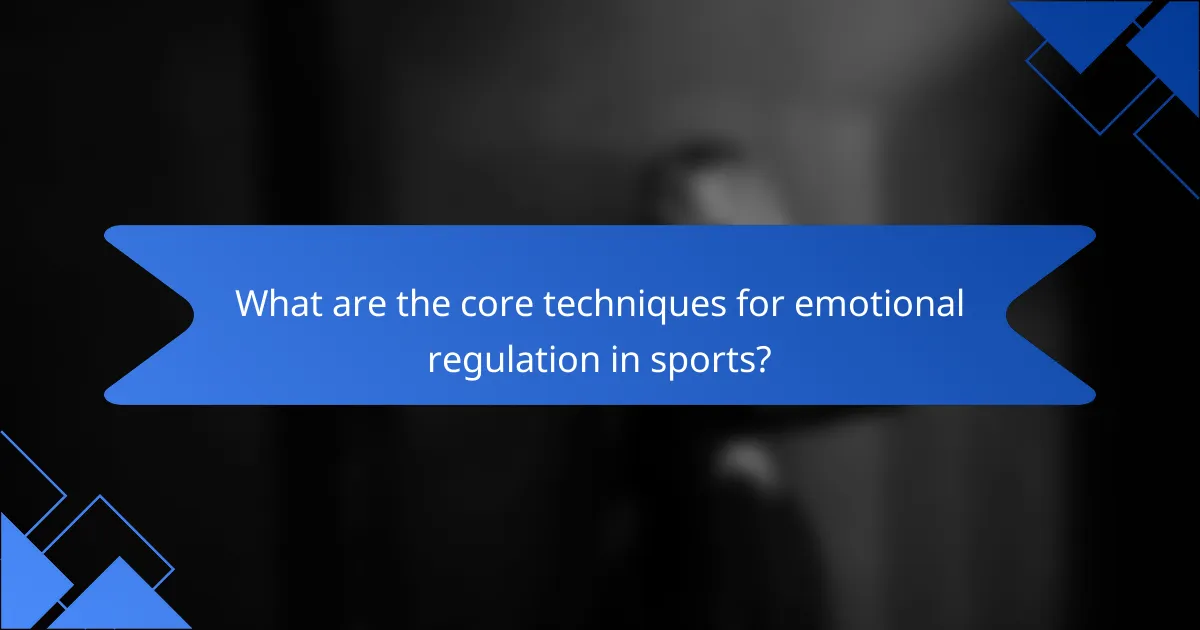
What are the core techniques for emotional regulation in sports?
Core techniques for emotional regulation in sports include mindfulness, cognitive restructuring, and breathing exercises. These techniques enhance performance, resilience, and mental toughness. Mindfulness helps athletes stay present, reducing anxiety. Cognitive restructuring enables athletes to challenge negative thoughts, promoting a positive mindset. Breathing exercises regulate physiological responses to stress, improving focus and composure during competition. Each technique contributes uniquely to emotional stability, fostering a conducive environment for peak performance.
How does emotional regulation impact athletic performance?
Emotional regulation significantly enhances athletic performance by improving focus, resilience, and mental toughness. Techniques such as mindfulness, cognitive restructuring, and controlled breathing help athletes manage stress and anxiety. For example, mindfulness practices can lead to a 20% increase in concentration levels during competitions. These strategies enable athletes to maintain composure under pressure, ultimately improving their performance outcomes.
What role does resilience play in emotional regulation?
Resilience significantly enhances emotional regulation by enabling athletes to manage stress and recover from setbacks. It fosters mental toughness, allowing individuals to maintain focus and composure during high-pressure situations. Techniques such as visualization, mindfulness, and positive self-talk strengthen resilience, improving overall performance. Research shows that resilient athletes demonstrate better emotional control, leading to consistent performance under varying conditions.
How can mental toughness be developed through emotional regulation?
Emotional regulation can enhance mental toughness through techniques like mindfulness, cognitive restructuring, and self-talk. These methods help athletes manage stress, maintain focus, and develop resilience. Mindfulness improves awareness of emotions, enabling better responses to challenges. Cognitive restructuring allows athletes to reframe negative thoughts, fostering a positive mindset. Self-talk provides motivational reinforcement, boosting confidence during competition. Together, these techniques cultivate emotional control, ultimately enhancing performance and mental toughness in sports.

What are the universal attributes of emotional regulation techniques?
Techniques for emotional regulation in sports focus on enhancing performance, resilience, and mental toughness. Universal attributes include cognitive restructuring, mindfulness practices, emotional awareness, and self-regulation strategies. These techniques empower athletes to manage stress, maintain focus, and improve overall mental well-being.
What are the foundational methods for managing emotions in high-pressure situations?
Mindfulness, cognitive restructuring, and breathing techniques are foundational methods for managing emotions in high-pressure situations. These strategies enhance performance and resilience by allowing athletes to maintain focus and composure. Mindfulness encourages present-moment awareness, reducing anxiety. Cognitive restructuring involves reframing negative thoughts, promoting a positive mindset. Breathing techniques help regulate physiological responses, fostering calmness. Implementing these methods consistently can significantly improve mental toughness in competitive environments.
How do athletes commonly implement emotional regulation strategies?
Athletes commonly implement emotional regulation strategies to enhance performance and resilience. Techniques include mindfulness, cognitive restructuring, and visualization. Mindfulness helps athletes stay present, reducing anxiety. Cognitive restructuring involves reframing negative thoughts to promote a positive mindset. Visualization allows athletes to mentally rehearse successful performances, boosting confidence. These techniques collectively foster mental toughness, a unique attribute essential for high-level competition.

What unique emotional regulation techniques are used by elite athletes?
Elite athletes utilize unique emotional regulation techniques such as visualization, mindfulness, and self-talk to enhance performance and resilience. Visualization involves mentally rehearsing successful performances, which can improve focus and confidence. Mindfulness practices help athletes stay present, reducing anxiety and enhancing emotional control. Self-talk allows athletes to maintain a positive mindset, countering negative thoughts and fostering mental toughness. These techniques are crucial for managing stress and maintaining peak performance in high-pressure situations.
How do visualization techniques enhance emotional regulation?
Visualization techniques significantly enhance emotional regulation by allowing athletes to mentally rehearse scenarios, manage anxiety, and improve focus. These techniques foster resilience and mental toughness, crucial for peak performance. For instance, athletes can visualize successful outcomes, which increases self-efficacy and reduces stress. Research indicates that mental imagery can activate similar brain regions as actual performance, reinforcing confidence and emotional control. Additionally, consistent practice of visualization can lead to improved coping strategies during high-pressure situations, ultimately enhancing overall athletic performance.
What is the significance of self-talk in emotional management?
Self-talk is crucial in emotional management as it influences athletes’ performance and resilience. Positive self-talk enhances focus and reduces anxiety, while negative self-talk can hinder performance. Techniques like reframing thoughts and using affirmations help athletes manage emotions effectively. Research shows that athletes who practice constructive self-talk demonstrate improved mental toughness and emotional regulation during high-pressure situations.
How do breathing exercises contribute to emotional stability?
Breathing exercises significantly enhance emotional stability by promoting relaxation and reducing anxiety. These techniques activate the parasympathetic nervous system, leading to decreased stress levels.
Research indicates that controlled breathing can lower cortisol, a stress hormone, and improve focus. For athletes, this translates to better performance and resilience under pressure. Regular practice can also cultivate mental toughness, allowing individuals to remain calm in challenging situations.
Additionally, breathing exercises can serve as a unique attribute of emotional regulation strategies, offering immediate benefits without requiring extensive time commitments. Incorporating these practices into training routines can foster a more balanced emotional state, ultimately enhancing overall athletic performance.
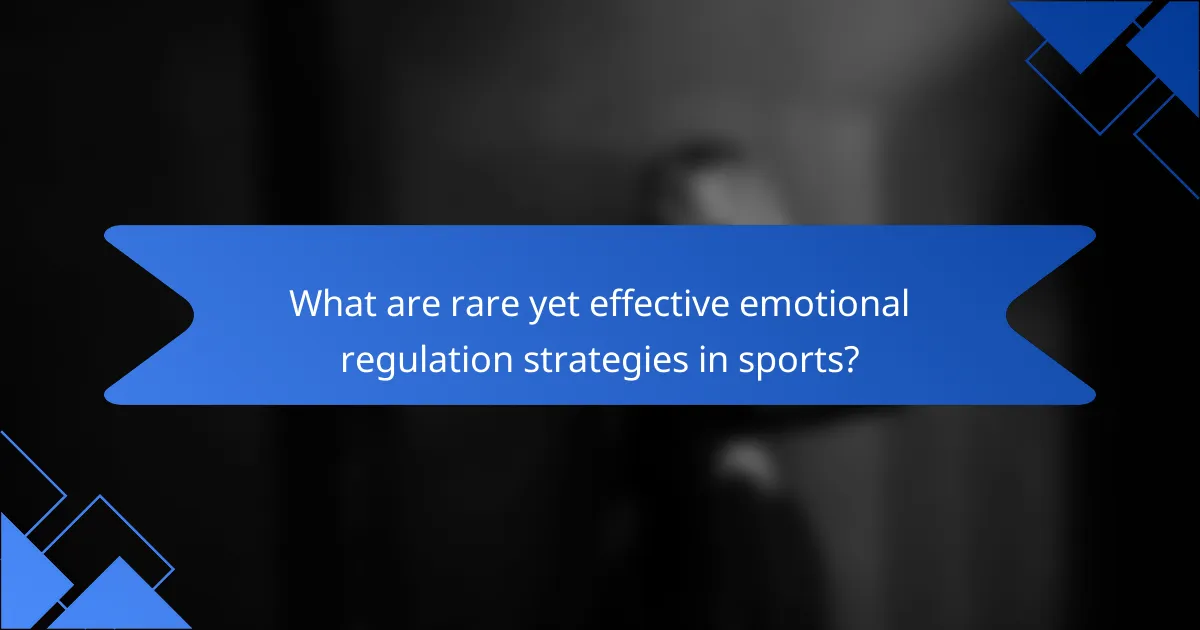
What are rare yet effective emotional regulation strategies in sports?
Rare yet effective emotional regulation strategies in sports include visualization, mindfulness training, and controlled breathing techniques. These methods enhance focus and reduce anxiety during competition. Visualization helps athletes mentally rehearse success, while mindfulness fosters present-moment awareness, promoting resilience. Controlled breathing regulates physiological responses, aiding emotional stability. Incorporating these strategies can significantly boost mental toughness and performance in high-pressure situations.
How can biofeedback be utilized for emotional regulation?
Biofeedback can effectively enhance emotional regulation by providing real-time data on physiological responses. This technique helps athletes recognize stress signals, enabling them to adjust their emotional state for improved performance.
Utilizing biofeedback, athletes can learn to control heart rate, muscle tension, and breathing patterns. This process fosters resilience and mental toughness by promoting self-awareness and emotional control during high-pressure situations.
Research indicates that biofeedback training can lead to a significant reduction in anxiety levels, enhancing focus and decision-making abilities. Regular practice can create a unique attribute of emotional resilience, crucial for competitive environments.
Incorporating biofeedback into training regimens allows athletes to develop a deeper understanding of their emotional triggers, ultimately leading to better emotional regulation and performance outcomes.
What innovative approaches are emerging in emotional regulation?
Innovative approaches in emotional regulation for sports focus on mindfulness techniques, biofeedback, and cognitive restructuring. Mindfulness enhances athletes’ awareness of emotions, enabling better management under pressure. Biofeedback provides real-time data on physiological responses, fostering self-regulation. Cognitive restructuring helps athletes reframe negative thoughts, promoting resilience and mental toughness. These methods collectively enhance performance and emotional stability.
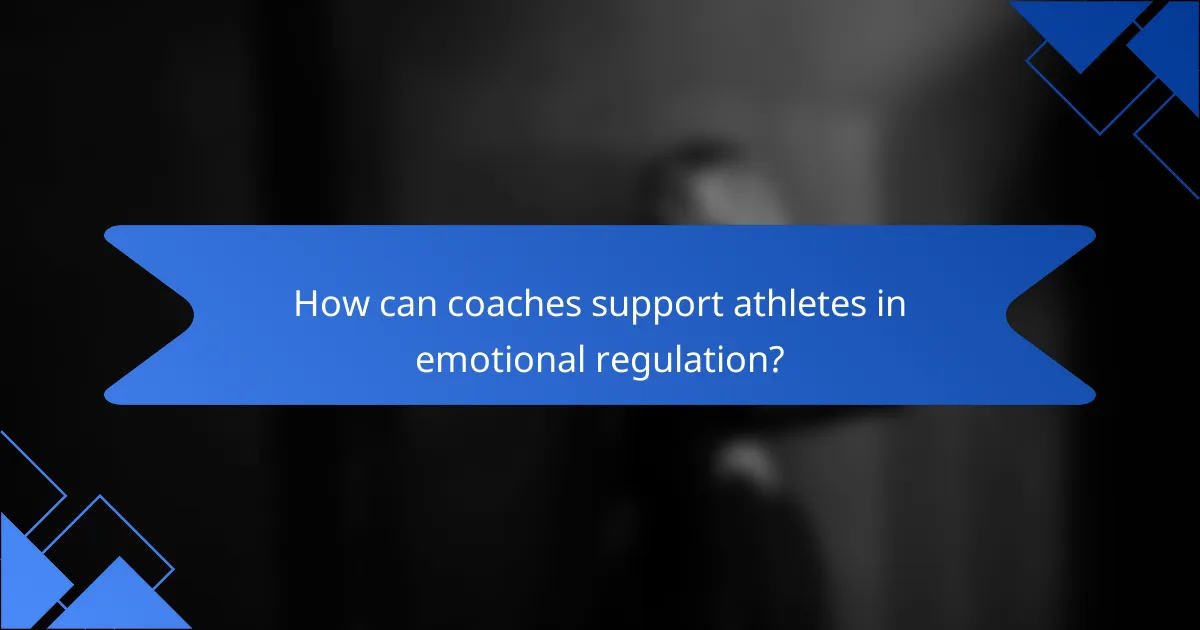
How can coaches support athletes in emotional regulation?
Coaches can support athletes in emotional regulation by implementing specific techniques. These techniques include mindfulness training, cognitive restructuring, and emotional awareness exercises. Mindfulness training enables athletes to stay present, reducing anxiety and enhancing focus. Cognitive restructuring helps athletes reframe negative thoughts, fostering a positive mindset. Emotional awareness exercises increase recognition of emotions, allowing for better management during competition. Collectively, these methods enhance performance, resilience, and mental toughness in sports.
What training programs focus on emotional regulation for athletes?
Training programs that focus on emotional regulation for athletes include cognitive-behavioral techniques, mindfulness training, and biofeedback. These programs enhance performance by teaching athletes to manage stress and emotions effectively. For example, cognitive-behavioral techniques help athletes identify negative thought patterns and replace them with positive affirmations, improving resilience. Mindfulness training promotes present-moment awareness, reducing anxiety during competitions. Biofeedback provides real-time data on physiological responses, enabling athletes to adjust their emotional states. Programs like these foster mental toughness, crucial for high-level performance.
How can team dynamics influence emotional regulation practices?
Team dynamics significantly enhance emotional regulation practices by fostering a supportive environment. Positive interactions among team members can lead to improved emotional awareness and expression. Techniques such as open communication and collective goal-setting strengthen resilience. As a result, athletes develop better coping strategies during high-pressure situations. This synergy not only boosts performance but also cultivates mental toughness, essential for success in sports.
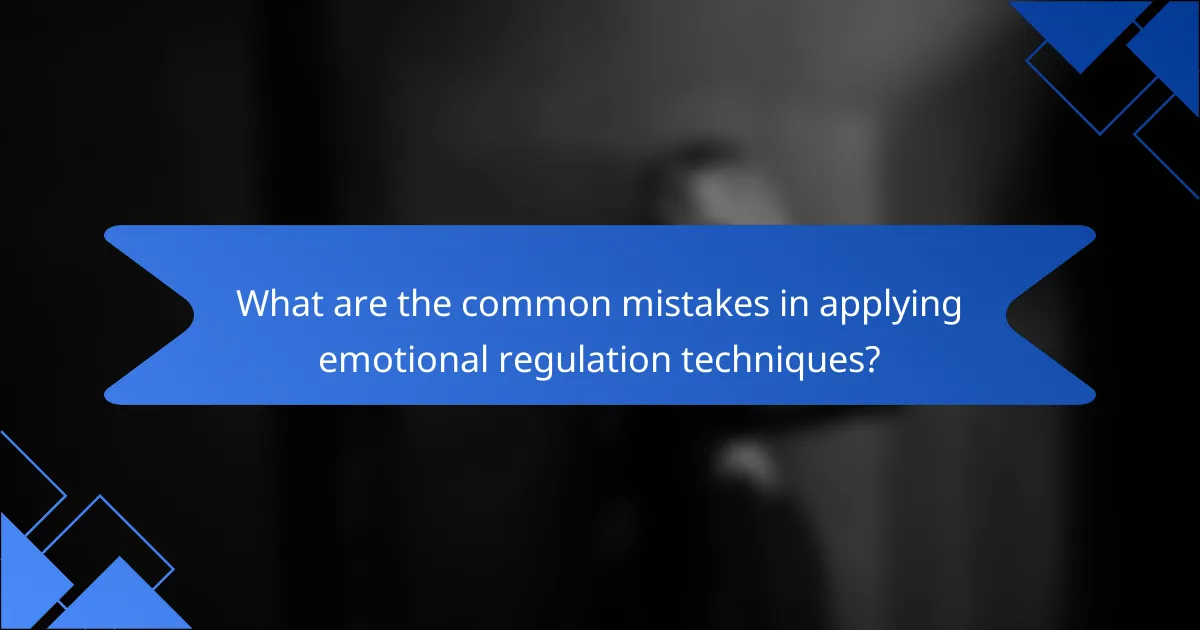
What are the common mistakes in applying emotional regulation techniques?
Common mistakes in applying emotional regulation techniques include inconsistent practice, neglecting individual differences, and focusing solely on avoidance strategies. Many athletes fail to integrate these techniques into their routine, reducing their effectiveness. Additionally, overlooking personal triggers can hinder progress, as emotional responses vary widely among individuals. Lastly, relying exclusively on suppression rather than constructive expression can lead to negative outcomes, such as increased anxiety or frustration.
What best practices can athletes adopt for effective emotional regulation?
Athletes can adopt several best practices for effective emotional regulation, enhancing performance and resilience. Techniques include mindfulness meditation, which promotes awareness and reduces anxiety, and cognitive restructuring to challenge negative thoughts. Visualization helps athletes mentally rehearse successful outcomes, while breathing exercises can quickly alleviate stress. Establishing a routine for pre-competition preparation fosters emotional stability. Regular self-reflection through journaling encourages awareness of emotional triggers, aiding in proactive management. These strategies collectively enhance mental toughness and performance consistency.
How can athletes optimize their emotional regulation strategies for peak performance?
Athletes can optimize emotional regulation strategies through mindfulness, cognitive restructuring, and visualization techniques. Mindfulness enhances present-moment awareness, reducing anxiety. Cognitive restructuring helps athletes reframe negative thoughts into positive ones, fostering resilience. Visualization prepares the mind for competition, improving focus and confidence. Regular practice of these techniques builds mental toughness, leading to peak performance.
